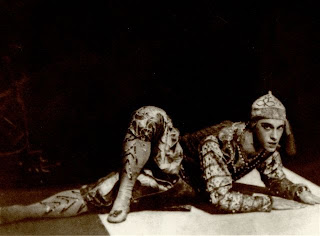
If I had the hours to spend a weekend in a museum, just about any museum, I would be there in a heart beat. I read about the Diaghilev ballet costume exhibit at the Victoria and Albert Museum in London and sadly know this is another bit of history I'll never get to see. Imagine staring at Nijinsky's costumes and watching vintage footage of him dancing in that very outfit. I'm a museum junkie and think this exhibit is worth a little extra promo by the Hoydens, even though most of us won't get to travel to London to see it (maybe the exhibition will come stateside someday!). This from The New York Times: ttp://www.nytimes.com/2010/09/24/arts/design/24antiques:
"The ballet impresario Serge Diaghilev hired boldface names like Picasso, Matisse, Georges Braque and Coco Chanel to design his costumes. While traveling to several continents with the Ballets Russes, Diaghilev was mercurial and demanding, and his tastes in fabric patterns ranged from Russian folk art to Rococo curlicues and Art Deco sunbursts. The dancers’ outfits ended up stitched with tinsel and mica, trimmed in lace and fur and puffed out around metal and wicker frames.
The company disbanded right after his death in 1929, and a few of his colleagues and fans stored away chunks of the costume collection until the 1960s. Sotheby’s in London then dispersed it in a series of sales. Diaghilev’s paperwork was also broken up over the years.
“It was all very scattered,” said Jane Pritchard, a curator of “Diaghilev and the Golden Age of the Ballets Russes, 1909-1929,” which opens on Saturday at the Victoria and Albert Museum in London.
The museum has reassembled about 60 outfits, many of them purchased decades ago at Sotheby’s auctions. The curators had to decide which ones would be strong enough to exhibit, and conservators have repaired rips and sweat damage, straightened bent flaps and reinforced shoulders for draping on mannequins.
“It’s like the costumes had to audition for us, to see if they’d get in,” Ms. Pritchard said.
Vintage footage of dancers streams in the galleries, and two stage drapes displayed measure up to 45 feet long: one shows a pair of Picasso semi-nudes on the run, and on the other, the Russian-born artist Natalia Goncharova laid out a tableau of gilded onion domes. The museum has also brought out ballerinas’ makeup tubes, castanets and satiny shoes, as well as paperwork that survived the Ballets Russes archival diaspora. The museum owns receipts for wigs and restaurant meals, and a 1924 contract letter from the dancer Vera Savina, one of at least two women who enraged Diaghilev by marrying one of his bisexual ex-boyfriends.
The exhibition catalog discusses Diaghilev’s messy personal life and his professional “constant search for novelty” and need for cash. He sometimes resorted to a kind of elite pimping. To wrangle donations from Lord Rothermere, a newspaper magnate, Diaghilev threw parties while “fostering Rothermere’s close relationship with the dancer Alice Nikitina,” the historian Sarah Sonner writes in the catalog.
Diaghilev invested some of his profits in costumes that turned out to be impractical. Chanel’s loose-fitting knit swimsuits were “potentially dangerous,” writes the dance historian Sarah Woodcock; a male dancer would have trouble keeping “a firm grip on his partner in the complex throws and catches.” Hoop skirts cut dancers’ shins and left them tottering during spins, and arched headdresses “slipped and were then impossible to adjust,” she writes.
As the ballet company traipsed through 19 countries, from Monaco to Uruguay, she adds, “Excess baggage costs were a major drain.”
Several other Ballets Russes studies have come out in the last few months. In addition to a gossipy Diaghilev biography from Oxford University Press by Sjeng Scheijen (an adviser to this show), the historian Mary E. Davis’s “Ballets Russes Style: Diaghilev’s Dancers and Paris Fashion” (Reaktion Books/University of Chicago Press) traces the costumes’ influence, from Paul Poiret’s 1910s harem pants and togas to Karl Lagerfeld’s 2009 collection with Russian models wearing Cossack boots.
The Antique Collectors’ Club and Hatje Cantz have both released monographs about Goncharova, one of Diaghilev’s favorite designers. An architect’s daughter from a village south of Moscow, she helped invent a style of furiously crisscrossing lines called Rayism. In 1915 Diaghilev lured her to Paris, and then the Russian Revolution marooned her in the West.
She based her Ballets Russes designs on flamenco dancers’ ruffles, Byzantine art and Russian Orthodox priestly robes and icons. The museum, in addition to hanging Goncharova’s huge stage backdrop, is showing her sketches of flowered peasant outfits, her costumes embroidered with sea creatures and a Cubist caricature of Diaghilev she drew. She abstracted his image into what looks like just an ear, a rotund belly and a sternly outstretched arm."
Imagine having to repair sweat stains and bent flaps on costumes...as if they were worn just yesterday! Cool.
Anybody have any museum exhibits they've been to recently they'd love to share?
No comments:
Post a Comment